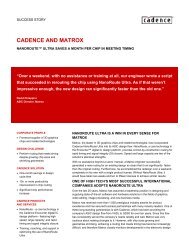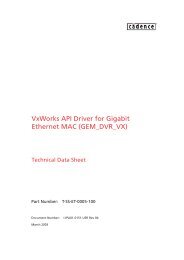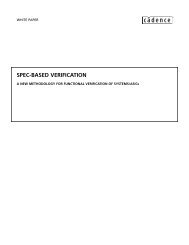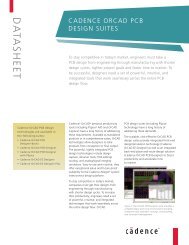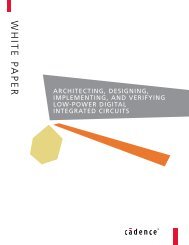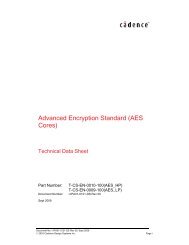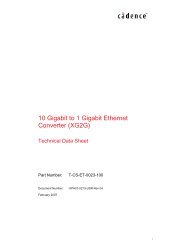A Nonlinear Capacitor Model for Use in PSpice - Cadence ...
A Nonlinear Capacitor Model for Use in PSpice - Cadence ...
A Nonlinear Capacitor Model for Use in PSpice - Cadence ...
Create successful ePaper yourself
Turn your PDF publications into a flip-book with our unique Google optimized e-Paper software.
APPLICATION NOTEA <strong>Nonl<strong>in</strong>ear</strong> <strong>Capacitor</strong> <strong>Model</strong> <strong>for</strong> <strong>Use</strong> <strong>in</strong> <strong>PSpice</strong>Source: OrCAD Technical Support, April 1999Revised by: Brian Hirasuna, April 1999Edited by: Coby Bassett, May 1999
TheoryThe charge and current <strong>for</strong>mulas <strong>for</strong> a l<strong>in</strong>ear capacitor are:Q = C * VI = C * dV(t)/dt(1a)(1b)For a nonl<strong>in</strong>ear (voltage-dependent) time-<strong>in</strong>dependent capacitor these <strong>for</strong>mulae become:Q = C(V) * dVI = C(V) * dV/dt(2a)(2b)This applies to cases where the capacitance has been measured at different bias voltages.Some would argue that <strong>for</strong> a nonl<strong>in</strong>ear capacitor,Q = C(V) * V(3a)where V is a function of time. There<strong>for</strong>e,I = dQ/dt = C(V(t)) * dV(t)/dt + dC(V(t))/dt * V(t) (3b)This is not correct. The flaw <strong>in</strong> this argument is equation (3a). Although (1a) holds true<strong>for</strong> l<strong>in</strong>ear capacitors, the generalized def<strong>in</strong>ition of charge is (2a). Capacitance is thepartial derivative of Q with respect to V; which meansI = dQ/dt = Q/V * dV/dt = C(V) * dV/dt (4)Given this relationship between the current through a nonl<strong>in</strong>ear capacitance and thevoltage applied to it, analog behavioral model<strong>in</strong>g can be used to model any nonl<strong>in</strong>earcapacitor whose capacitance, C(V), is a function of the voltage applied to it.The <strong>Model</strong>The nonl<strong>in</strong>ear capacitor is modeled by us<strong>in</strong>g ABM (Analog Behavioral <strong>Model</strong><strong>in</strong>g). Thecapacitor is replaced by a controlled current source, Gout, whose current is def<strong>in</strong>ed by(2b). The time derivative, dV(t)/dt, is modeled by us<strong>in</strong>g the DDT( ) function <strong>in</strong><strong>PSpice</strong> ® . A voltage dependent capacitance can be specified by us<strong>in</strong>g a look-up table, orby us<strong>in</strong>g a polynomial.Look-up Table ExampleIf a Capacitance vs. Voltage curve is available, a look-up table can be used <strong>in</strong> the ABMexpression. This table conta<strong>in</strong>s (Voltage, Capacitance) pairs picked from po<strong>in</strong>ts on thecurve. The voltage <strong>in</strong>put is nonl<strong>in</strong>early mapped from the voltage values <strong>in</strong> the table to thecapacitance values. L<strong>in</strong>ear <strong>in</strong>terpolation is used between table values. This voltagedependent capacitance is the multiplied by the time derivative of the voltage to obta<strong>in</strong> theoutput current.2APPLICATION NOTE
Fig 1. <strong>Nonl<strong>in</strong>ear</strong> capacitor with look-up table expressionPolynomial ExampleFig 2. <strong>Nonl<strong>in</strong>ear</strong> capacitor with polynomial expressionThe value of the nonl<strong>in</strong>ear capacitor model <strong>in</strong> this example has a second orderpolynomial dependence on its voltage. This is equivalent to the standard <strong>PSpice</strong> capacitormodel, whose l<strong>in</strong>ear and quadratic coefficients, VC1 and VC2, can be def<strong>in</strong>ed <strong>in</strong> a.MODEL statement. This model is parameterized so that users can specify the polynomialcoefficients <strong>in</strong> a parameter block (the PARAM symbol), or on the symbol <strong>in</strong> theschematic editor.Example SimulationA transient analysis can be run to verify the model.Fig 3. Test circuit <strong>for</strong> voltage-controlled capacitor3APPLICATION NOTE
Fig 4. <strong>PSpice</strong> plot of transient analysis resultsThe transient analysis slowly varies the voltage across the capacitor from 1V to 50V. Theeffective capacitance can be viewed <strong>in</strong> <strong>PSpice</strong> as the expression: -I(V1)/D(V(V1:+)), which is derived from equation (2b). D( ) is the derivativewith respect to time. The m<strong>in</strong>us (-) sign is required because <strong>PSpice</strong> measures voltagesource currents as flow<strong>in</strong>g from the positive node to the negative. <strong>PSpice</strong> will show thatthe capacitance varies from 1.02u(F) to 1.78u(F).Sett<strong>in</strong>g Initial ConditionsThe IC1 and IC2 symbols <strong>in</strong> special.olb (or the .ic statement <strong>in</strong> an Include file)can be used to specify <strong>in</strong>itial conditions <strong>for</strong> the capacitor.© 1999 <strong>Cadence</strong> Design Systems, Inc. All rights reserved. <strong>Cadence</strong>, the <strong>Cadence</strong> logo,and <strong>PSpice</strong> are registered trademarks of <strong>Cadence</strong> Design Systems, Inc. All others areproperties of their respective holders.4APPLICATION NOTE



